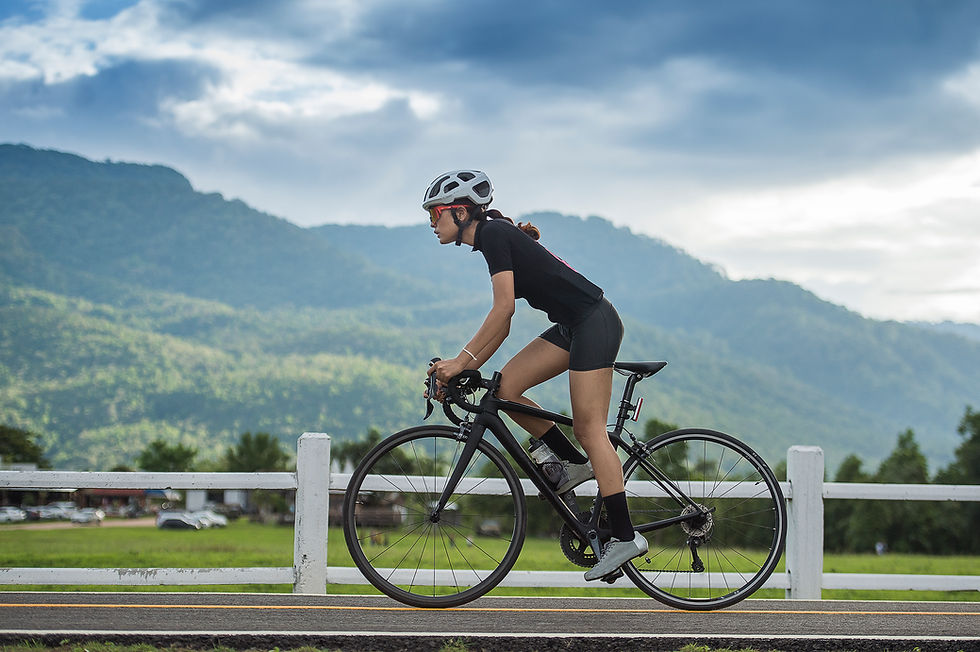How cycling benefits runners
- Henry Howard

- May 11
- 3 min read

By Henry Howard
Runners who include cycling for fitness often find the bike training can increase muscular endurance, boost overall adaptability and improve performance in both disciplines. Here is how runners benefit from cycling.
Raise intensity while lowering impact
Many runners struggle to train consistently due to a variety of work issues, family or life commitments, a gap in motivation, injuries or other factors. Cycling offers runners a way to increase their running volume, and or incorporate higher intensity efforts. Biking — either indoors on a trainer or outside — allows you to perform at higher intensity levels without dramatically increasing impact.
Think about it: Every foot strike while running levels impact on your bones, muscles, tendons, and ligaments — up to three times your body weight in ground reaction force. That’s one key reason why coaches often mandate easier runs for the majority of the time. After all, the impact forces only increase as running speed advances.
How runners should add cycling to training
Bike workouts can improve aerobic development for individuals who are limited by running hours their bodies can tolerate. Cycling allows athletes accumulate significant more time at the prescribed cardiovascular intensity.
It is clear how cycling benefits runners. So what is the best way to get started on the bike?

As an endurance runner and running coach who has incorporated cycling into his routine (and the plans of some of his athletes), I use cycling as my preferred option for cross-training.
While there are too many variables to cite an example I prescribe for an athlete, I’ll use my own routine as an example.
In most weeks, I run five days a week, take one full rest day and use one day for time on the bike. I usually do about an hour of cycling with some intensity on what otherwise is a rest and recovery day. Additionally, during building phases of my training, I add one or two shorter rides to supplement my running. Those rides are shorter and easier, aiming to improve my cardio without the wear and tear on my lower leg muscles, tendons, bones, etc.
If you choose, you can rev up intensity by adding fast intervals, adjusting the tension or using climbs. Just be sure that you are leaving enough recovery time for your key running workouts after doing any intense rides.
During the colder months, I use my stationary bike and Zwift app to find some fun and/or challenging rides. During warmer months, I often head outside for a ride on the roads or trails.

Cycling workouts for runners
Here are three sample workouts for runners, aimed at three different type of rides:
• Recovery ride on a double day: This is intended to be the second part of a double following a run earlier in the day. After recovering during the day, bike for between 30 and 45 minutes, keeping the effort level around a Zone 2 (out of 7) for the vast majority of the ride. Mix in some short intervals, around two to three bursts of no more than one minute each would be ideal. This type of ride will build on your cardio fitness without compromising the health of your lower legs.
• Weekly long ride: This is the type of ride I do for my active recovery day, in addition to five days of running and one day of rest. I generally ride for between 45 and 75 minutes with most of the ride in Zone 2. But there is a greater percentage of time in higher zones. One such workout would be a 10- to 15-minute warmup; then interval training for between 30 and 45 minutes alternating between a higher zone and moderate zone (2 minutes Z5, 2 minutes Z3, 10 times total, for example); and finishing with up to 10 minutes of easy cycling. This is an especially good type of workout for masters or oft-injured runners who can build fitness through a workout without the pounding of the roads or even the trails.
• Easy ride for recovery: Similar to the first example, this ride is intended for pure recovery, often as a way to transition back to activity after a hard effort like a race. This ride is performed at a low intensity, Z1 or perhaps pushing into Z2 for a brief period. A 30-minute ride at this intensity will do wonders for tired legs and set you up well for the next run.
Note to readers: If you like my advice and are looking for a running coach, I currently have some openings. Feel free to connect with me and we can set up a free, no-obligation consultation to see if we are a good fit.







Comments